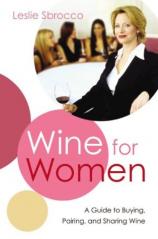Excerpt
Excerpt
Wine for Women: A Guide to Buying, Pairing, and Sharing Wine

White Wine
Chardonnay/White Burgundy
The "Basic Black" of White Wine
Buying
If you're like me, black is a wardrobe staple. Your closet overflows with black purses in various shapes and sizes, pants and jackets from casual to upscale, and most important, that little black dress. Let's not forget shoes: black flats, heels, and boots in every imaginable style. And if you're like me, you keep buying more black. It's not that bright colors are bad. On the contrary, they're fabulous. But pulling off the cherry-red suit or floral-print pants can take a little doing. Nothing is as slimming, versatile, popular, or easy as black. Except for the slimming part (although there are only around 100 calories per glass), the same words can be used to describe Chardonnay, which I think of as the basic black of white wines. Chardonnay is simple to sip, goes with many kinds of food, and remains wildly popular.
The Grape Story
A classic grape variety that was not well known in this country until a few decades ago, Chardonnay has made a name for itself. Today it's the number-one-selling white in America, and "I'll have the Chardonnay" has become a national motto. Look at any restaurant wine list and count the Chardonnays. Better yet, walk into a retail store where Chardonnays are packed from floor to ceiling, dominating the wine aisles.
Chardonnay is familiar, and that familiarity inspires confidence and comfort. We know it; therefore we love it. But Chardonnay's popularity is due in large part to its versatility. Just like those black pants that come in many fabrics and styles -- from casual cotton to sleek silk -- Chardonnay can be everything from light and crisp to juicy and soft or buttery and full.
Why is Chardonnay so versatile? It has to do with the grape's personality. Chardonnay was at the head of the line when the grape god handed out easygoing personalities. Not naturally tart and aggressive like Sauvignon Blanc or floral and flirtatious like Gewurztraminer, Chardonnay's mild-mannered fruitiness lends itself to making all kinds of wine.
Chardonnay takes on character and complexity depending on where the grapes are grown and who turns them into wine. Many versions are successful; others are not. With an estimated seven hundred different Chardonnay bottlings on store shelves at any one time, though, how do you sift through the boring to get to the beautiful?
Price is the first thing that comes to mind. Picking a bottle because it costs $10 or $30 is one way to choose a wine, but if you don't like the way the $30 bottle tastes, you are pouring money down the drain. The key to finding Chardonnay in your price range and then enjoying it begins with defining what you like and don't like. Do you prefer Chards that taste a bit tangy like citrus fruits or ones that are more ripe like pineapples? Or a lighter, more delicate Chardonnay versus a fuller, buttery one?
If you're shrugging your shoulders, wondering what in the world I'm talking about, have no fear. Let's take a lingo lesson and start to put words to wine.
Having a few key words under your wine belt will help you communicate better about Chardonnay and figure out the tastes and styles you like, but unfortunately, most stores and wineries don't boldly display their wines by taste. Believe it or not, though, labels can tell you something very important about the taste and style of a wine before you pull the cork.
Born in the USA . . . Or France . . . Or Chile
Several years ago, when I was hiking through hillside vineyards in the Aconcagua Valley of Chile, a winemaker made a remark that really hit home. As we nibbled on freshly plucked grapes, Tony Coltrin of Seña winery said, "Good wine tastes like a grape, but great wine tastes like a place."
He's so right. I can give you an idea of what basic Chardonnay might taste like, but what about Chardonnay grown in Chablis or Carneros or Casablanca? Each place has a unique combination of sun, soils, and slopes, which makes the grapes grown there taste a certain way.
Luckily that location is on the label, and I think of it as the wine's birthplace. Before we even get to what the winemaker can do when turning grapes into wine (that comes next), the wine's birthplace has the biggest effect on the taste of a bottle of Chardonnay.
The following roundups highlight how wines from some of my favorite regions express themselves in the glass. Just as finding the perfect pair of black pants is simple when you know the style you want, buying wine is easier if you can link words on the label to your preferred style of Chardonnay.
Use these as a guideline to start exploring Chardonnays from different places around the globe. Bon voyage.
Excerpted from Wine for Women © Copyright 2003 by Leslie Sbrocco. Reprinted with permission by Cookbooks, an imprint of HarperCollins. All rights reserved.
Wine for Women: A Guide to Buying, Pairing, and Sharing Wine
- hardcover: 352 pages
- Publisher: William Morrow Cookbooks
- ISBN-10: 0060523328
- ISBN-13: 9780060523329

